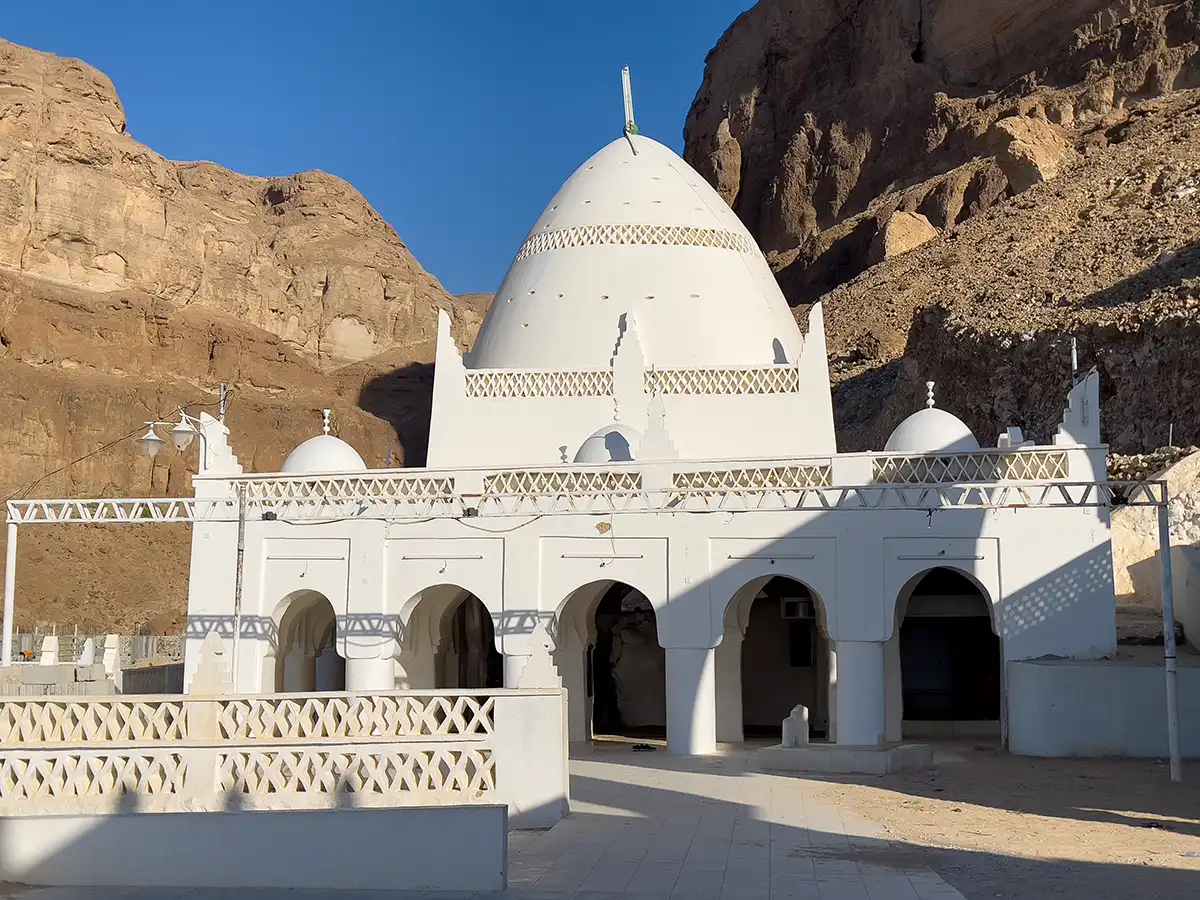Sacred Sites of Yemen
Hood Prophet Shrine, Qabr Hud, Hadhramaut
Nestled amid the dramatic desert landscape of Wadi Hadhramaut lies the shrine of Prophet Hud (Hood), an important figure mentioned in the Quran. According to Islamic tradition, Hud was sent to guide the ancient people of 'Ad, and his final resting place is believed to be at this remote location. The shrine complex features a modest white-domed structure housing the tomb, surrounded by stone buildings that accommodate pilgrims. Each year during the Islamic month of Sha'ban, thousands of devotees gather here for the Ziyara of Prophet Hud, one of Yemen's largest religious festivals. The pilgrimage involves several days of prayers, recitations, and religious ceremonies in this starkly beautiful landscape, where visitors must travel through challenging terrain of valleys and mountains to reach this sacred destination.
Al Muhdhar Mosque, Tarim
Located in the ancient city of Tarim in Hadhramaut Governorate, Al Muhdhar Mosque stands as one of Yemen's most iconic Islamic monuments. Built in 1914, this striking white structure with its distinctive 46-meter-tall minaret is considered a masterpiece of Hadhrami architectural style. The mosque is named after the revered scholar and saint Omar Al-Muhdhar and serves as both a functioning mosque and a major center for Islamic learning in the region. With its ornate plasterwork, intricate wooden ceilings, and distinctive design elements, the mosque attracts pilgrims and visitors from across the Islamic world who come to admire its beauty and pay respects to the scholarly legacy of the Al-Muhdhar family.
Shrine of Imam Sheikh Abu Bakr bin Salem, Einat
In the small town of Einat in Hadhramaut lies the revered shrine of Sheikh Abu Bakr bin Salem Al-Alawi (1514-1584), one of the most influential Sufi scholars and saints in Yemen's history. The shrine complex includes a mosque, a mausoleum, and facilities for pilgrims and students. Known for his piety, wisdom, and miraculous deeds, Sheikh Abu Bakr's legacy continues to draw devotees from across Yemen and the broader region, particularly from Indonesia and Malaysia where his teachings have a significant following. The annual commemoration of his death (known as the Hawl) transforms this normally quiet town into a vibrant gathering of thousands who come to recite prayers, participate in dhikr ceremonies, and seek blessings. The shrine's architecture represents the distinctive style of Hadhramaut, featuring white-washed walls, wooden decorations, and intricate plasterwork.
Tomb of Syedna Hatim bin Ibrahim al-Hamidi, Jabal Kawkaban
Perched atop the dramatic mountain fortress town of Kawkaban, approximately 2,800 meters above sea level, stands the tomb of Syedna Hatim bin Ibrahim al-Hamidi, a significant figure in Ismaili history who served as the 3rd Dai al-Mutlaq (absolute missionary) of the Tayyibi Ismaili Muslims from 1162 to 1199 CE. The tomb is housed within a modest stone structure that blends harmoniously with the ancient architecture of this mountaintop settlement. For Dawoodi Bohras and other Ismaili communities, this site represents an important spiritual connection to their heritage in Yemen, which served as a sanctuary for their faith for centuries. The journey to the tomb itself is arduous, requiring visitors to climb ancient stone stairways carved into the mountainside, adding a physical dimension to the spiritual pilgrimage. From this elevated position, pilgrims can contemplate not only the religious significance of al-Hamidi's contributions to Islamic thought but also enjoy the breathtaking panoramic views of Yemen's northern highlands.
Great Mosque of Sana'a, Sana'a
The Great Mosque of Sana'a (Al-Jami' al-Kabir) is one of the oldest mosques in the Islamic world, believed to have been built during the lifetime of the Prophet Muhammad around 627-628 CE. Located in the heart of the UNESCO World Heritage-listed Old City of Sana'a, this mosque represents over 1,400 years of continuous Islamic worship and scholarship. The mosque's architecture has evolved over centuries, featuring distinctive Yemeni elements including ornate wooden ceilings, stained glass windows, and decorated pillars. Many of these pillars were repurposed from ancient pre-Islamic temples, connecting the site to even earlier religious traditions. The mosque houses an important collection of ancient manuscripts and was historically a major center for Islamic education.
Al-Janad Mosque, Taiz
Located near the city of Taiz in southwestern Yemen, Al-Janad Mosque is considered one of the earliest mosques built in Yemen and the Arabian Peninsula. Founded around 631 CE during the lifetime of Prophet Muhammad by his companion Mu'adh ibn Jabal, this ancient structure represents the early spread of Islam in Yemen. The mosque features distinctive architecture with multiple domes, arched corridors, and a spacious courtyard, blending early Islamic design with local Yemeni building traditions. For centuries, Al-Janad served as a prominent center of Islamic learning where scholars taught the Quran, Hadith, and Islamic jurisprudence. The surrounding cemetery contains the graves of numerous Islamic scholars and saints, making the entire complex a destination for religious visits and historical appreciation. Despite renovations over the centuries, the mosque retains much of its original character and continues to be an active place of worship and pilgrimage for Muslims seeking connection to the earliest days of Islam in Yemen.
Shrine of Ahmad ibn Alwan, Al-Hujaria
The shrine of Ahmad ibn Alwan (1222-1266 CE) is nestled in the mountainous region of Al-Hujaria, south of Taiz. Ibn Alwan was a renowned Sufi mystic, poet, and scholar whose writings on divine love and spiritual enlightenment continue to influence Yemeni religious thought. His tomb has become a significant pilgrimage destination, particularly for followers of mystical Islamic traditions. The shrine complex includes a mosque, meditation spaces, and accommodations for visitors. The annual festival commemorating his death brings together devotees who perform religious chants, recite his poetry, and engage in communal prayers. The site is known for its serene atmosphere, enhanced by its location among Yemen's terraced mountains and valleys. Many pilgrims visit seeking intercession, spiritual guidance, or healing, continuing a tradition of veneration that has persisted for over seven centuries despite the changing religious landscape of modern Yemen.
Mosque and Tomb of Al-Imam Al-Hadi Yahya bin Al-Hussein, Sa'dah
Located in the northern city of Sa'dah, the historical stronghold of Zaydi Islam in Yemen, stands the mosque and tomb complex of Imam Al-Hadi Yahya bin Al-Hussein (859-911 CE), the founder of the Zaydi state in Yemen. The complex represents the historical and spiritual heart of Zaydism, a branch of Shia Islam that has shaped northern Yemen's religious identity for over a millennium. The mosque features traditional Yemeni architectural elements with its distinctive minaret, arched walkways, and decorated prayer hall. Adjacent to the mosque lies the tomb of Al-Hadi, housed in a chamber adorned with inscriptions and religious calligraphy. For Zaydi Muslims, this site holds profound significance comparable to other major Shia shrines across the Islamic world.
Shrine of Sheikh Sa'id bin Isa Al-Amudi, Tarim
In the historic town of Tarim, known for its concentration of mosques and Islamic learning centers, lies the shrine of Sheikh Sa'id bin Isa Al-Amudi, a prominent 12th-century scholar and saint. Al-Amudi is particularly revered for spreading Islam throughout Southeast Asia, establishing connections that continue to bring Indonesian and Malaysian pilgrims to Yemen today. The shrine complex features traditional Hadhrami architecture with its distinctive white plasterwork and wooden elements. Inside, the tomb chamber is adorned with intricately woven textiles and religious inscriptions. The shrine serves as both a place of prayer and a symbol of Hadhramaut's far-reaching religious influence across the Indian Ocean world. Devotees visit to seek blessings, offer prayers, and connect with the spiritual lineage of Al-Amudi, whose descendants became influential religious leaders throughout the Indian Ocean rim.
Qubbat Al-Baydani, Zabid
In the ancient city of Zabid, once a thriving center of Islamic learning, stands the Qubbat Al-Baydani, a domed shrine dedicated to the 13th-century Sufi scholar and saint Ismail ibn Ibrahim Al-Baydani. The distinctive dome structure represents the classic Islamic funerary architecture found across Yemen, with its whitewashed exterior and carefully proportioned form. Zabid itself was historically known as "the city of 365 mosques," with Al-Baydani's shrine being among its most significant religious sites. The interior features traditional Islamic geometric patterns, calligraphy, and a central cenotaph covered with embroidered cloths. Local traditions hold that Al-Baydani possessed healing powers that continue to manifest at his shrine, drawing visitors seeking spiritual and physical remedies. The annual commemoration of his death transforms the quiet shrine into a center of communal celebration with recitations of the Quran, communal meals, and night-long dhikr ceremonies that showcase Yemen's rich tradition of religious music and chanting.
Tomb of Queen Arwa, Jibla
In the mountain town of Jibla in central Yemen lies the tomb of Queen Arwa bint Ahmad Al-Sulayhi, who ruled Yemen for over 50 years (1067-1138 CE) during the Sulayhid Dynasty. As a revered figure in Ismaili Islam, particularly for the Tayyibi branch, her tomb has become an important pilgrimage destination. Queen Arwa was known for her piety, wisdom, and patronage of religious learning, earning her the honorific title "Al-Sayyida Al-Hurra" (The Noble Lady). The tomb is housed within a mosque that she herself commissioned, showcasing traditional Yemeni architecture with its distinctive minaret and decorated prayer hall. For Ismaili Muslims, especially those from the Indian subcontinent with historical connections to Yemen's religious traditions, visiting her shrine represents a journey to honor one of the most powerful female rulers in Islamic history.
Al-Ashrafiya Mosque and Mausoleum, Taiz
Standing prominently in Yemen's cultural capital of Taiz is the Al-Ashrafiya Mosque and Mausoleum complex, commissioned in the early 15th century by Sultan Al-Ashraf Ismail, a ruler of the Rasulid dynasty. This architectural masterpiece represents the zenith of Islamic art in medieval Yemen, featuring intricate stucco decorations, carved wooden ceilings, and vibrant painted motifs that blend geometric patterns with floral designs. The mosque's interior is particularly renowned for its mihrab (prayer niche), adorned with delicate plasterwork and Quranic inscriptions executed in the distinctive Yemeni calligraphic style. Adjacent to the prayer hall lies the mausoleum containing the tomb of Sultan Al-Ashraf, making this site both a place of worship and royal commemoration. Throughout its history, the complex has served as an important center for religious education and pilgrimage.

Martin Gray is a cultural anthropologist, writer and photographer specializing in the study of pilgrimage traditions and sacred sites around the world. During a 40 year period he has visited more than 2000 pilgrimage places in 160 countries. The World Pilgrimage Guide at sacredsites.com is the most comprehensive source of information on this subject.


